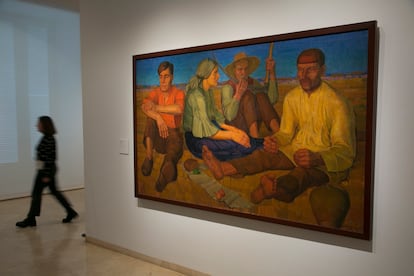Ukraine defends its cultural heritage under Putin’s bombs and attempts to reframe history
After the Russian invasion, the most precious pieces were evacuated from Kyiv to secret locations on trains that ran along the front lines under missile fire

Russian forces have damaged or looted part of Ukraine’s heritage in the occupied territories and, faced with the danger of further losses, Ukrainian museums and cultural institutions are moving to protect their works. Some items were evacuated to secret and presumably safe places on high-risk missions at the beginning of the war. Now, a decree by Russian President Vladimir Putin on state policy in the field of history outlines new threats to the study and interpretation of Ukrainian cultural patrimony.
From February 24, 2022, the start date of the full-scale Russian invasion, until the end of last April, a minimum of 1,066 objects were damaged in Ukraine in 18 regions, with Kharkiv being the most affected, according to the Ukrainian Ministry of Culture. Among the affected institutions is the museum in Ivanov, with a collection by the original self-taught painter Maria Primachenko (1909-1997), and also the museum dedicated to landscape painter Arkhip Kuindzhi (1840-1910) in Mariupol. Among the looted institutions were the Fine Arts Museum and the Kherson Regional Museum.
Russian tanks were already advancing through the country when Ukrainian museums were considering moving and hiding their art treasures. The Ministry of Culture acted slowly, according to two museum directors and three heritage specialists consulted by telephone in Kyiv by this newspaper. In contrast to the initial paralysis of cultural officials, Interior Minister Denís Monastirski took the initiative, says a source familiar with the matter. “At the end of February [2022] in Kyiv there was panic and people were fleeing. In that atmosphere, Monastirski found wagons for evacuation and arranged for a special escort. The museum directors carefully packed the works and when the Minister of Culture finally authorized the evacuation in early March, everything was ready,” says the same source.

Russian troops were only a few miles from Kyiv; trains carrying Ukraine’s cultural legacy were running parallel to the front line and were caught in the middle of the battle, the source recounts. “Missiles from one side and the other crossed over the convoy,” he says, referring to one such operation. A short distance from the railway line were the towns of Bucha and Irpin, the scene of atrocities carried out by the invading forces, who later withdrew. “The evacuation was not a specific phenomenon, but continued during April and May 2022, and many trains left the capital loaded with valuables,” says a second source with knowledge of the operation. Monastirski perished in January 2023 in a helicopter accident and the hiding place (or places) for the pieces is a state secret.
One of the institutions evacuated was the National Museum of History, located in the capital. From there, 120,000 objects were transferred, the museum’s director, Fedir Androschuk, tells EL PAÍS. Today, Androschuk is responsible for the gold pieces from Crimean museums, which were being exhibited in the Netherlands in 2014 when Russia invaded the peninsula. Androschuk says that he wants to exhibit these works in Kyiv, but does not know when that will be possible.
The St. Sophia Cathedral museum complex has also evacuated part of its treasures. This unparalleled institution in Ukraine has a vast territorial heritage, including excavations in Crimea, which it cannot access today. “Our valuable works are mostly monuments and interior architectural elements, which cannot be moved. Whatever we do, nothing can save us from a direct missile hit. We rely on Kyiv’s anti-aircraft defenses,” says its director Nelia Kukovalska.

Kukovalska collaborates with various European institutions, from the Mayor’s Office of Lisbon to the University of Valencia and the German Foreign Ministry. This department, she says, regularly sends her truckloads of restoration and conservation material to be distributed to provincial museums: “As many as 600 museums have benefited from it.”
An engineer by training, Kukovalska works on 3-D reproductions of the buildings in her custody and is skeptical of UNESCO, which, she says, “under the pretext of helping Ukraine, spends money on its own useless events.” Ukraine has eight sites on UNESCO’s list of world heritage cultural properties. The latest to join was the historic center of Odesa, which has not prevented Russian shelling of the city.
Both Androschuk and Kukovalska believe that Russia presents Ukraine’s cultural heritage as its own and as part of its own history. The Russian approach has roots in Europe, because European specialists have been trained on the basis of Russian historiography and interpretations, they point out. Kukovalska has sent a shipment of books to Oxford University to study other sources, and Androschuk says the creation of Ukrainian studies centers in European universities would help correct this situation.
The works stolen by Russia are today inaccessible to Ukrainian researchers. Two of them, affected by the war, hope that at least the Russian professionals at the museums where they will be taken will take responsibility for maintaining their good condition, aside from the high-ranking cultural officials who support the invasion. International exhibitions protect works of art by keeping them out of the war zone and this was the intention of Konstantin Akinsha, a veteran art specialist, who organized a traveling exhibition of Ukrainian avant-garde, which arrived in November 2022 at the Thyssen Museum in Madrid. The exhibition, now expanded, is currently in Vienna.
The loss of works is not all that can befall Ukraine’s heritage. A decree issued by the Russian president on May 8 also affects it. The text confirms “the foundations of the state policy of the Russian Federation in the sphere of historical education” and establishes an ideological framework that subordinates the study of history to Kremlin policy. The work of researchers, historians, and educators should be guided by love for the Russian homeland, traditional Russian values, the need to preserve the “unity of the state” and the “idea of Russia as a civilization,” says the document, which warns against “attempts to distort historical memory,” “distortion of historical truth” and “negative assessments of events and periods of the homeland’s history,” as well as “the dissemination of false images of Russia.”
Among its guidelines the decree highlights the role of the family and the military industry in historical science. Androschuk calls the decree “very dangerous” and sees it as the result of the collective work of various high-ranking Russian officials and museum directors in order to rewrite history.
Sign up for our weekly newsletter to get more English-language news coverage from EL PAÍS USA Edition
Tu suscripción se está usando en otro dispositivo
¿Quieres añadir otro usuario a tu suscripción?
Si continúas leyendo en este dispositivo, no se podrá leer en el otro.
FlechaTu suscripción se está usando en otro dispositivo y solo puedes acceder a EL PAÍS desde un dispositivo a la vez.
Si quieres compartir tu cuenta, cambia tu suscripción a la modalidad Premium, así podrás añadir otro usuario. Cada uno accederá con su propia cuenta de email, lo que os permitirá personalizar vuestra experiencia en EL PAÍS.
¿Tienes una suscripción de empresa? Accede aquí para contratar más cuentas.
En el caso de no saber quién está usando tu cuenta, te recomendamos cambiar tu contraseña aquí.
Si decides continuar compartiendo tu cuenta, este mensaje se mostrará en tu dispositivo y en el de la otra persona que está usando tu cuenta de forma indefinida, afectando a tu experiencia de lectura. Puedes consultar aquí los términos y condiciones de la suscripción digital.
More information
Archived In
Últimas noticias
Rowan Atkinson tops Netflix at 70: ‘He’s as funny as ever’
Israeli recognition of Somaliland stirs up the Gulf
Tiger Woods turns 50: Will he continue playing on the PGA Tour or take a back seat?
The surreal journey of James Nnaji, the Barcelona youth player selected in the NBA Draft who ended up in the NCAA
Most viewed
- Oona Chaplin: ‘I told James Cameron that I was living in a treehouse and starting a permaculture project with a friend’
- Reinhard Genzel, Nobel laureate in physics: ‘One-minute videos will never give you the truth’
- Sinaloa Cartel war is taking its toll on Los Chapitos
- Why the price of coffee has skyrocketed: from Brazilian plantations to specialty coffee houses
- Chevy Chase, the beloved comedian who was a monster off camera: ‘Not everyone hated him, just the people who’ve worked with him’











































